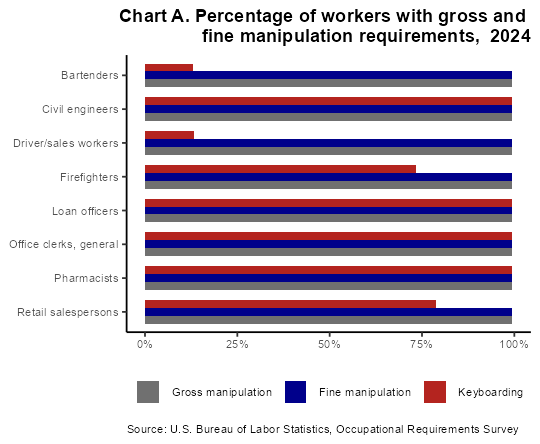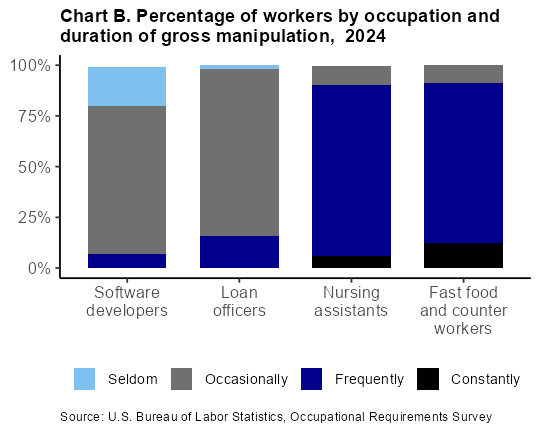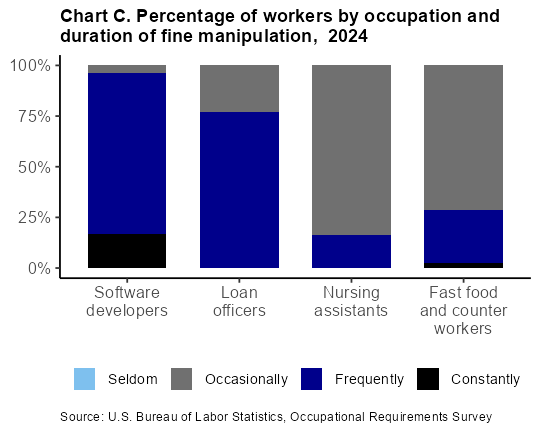An official website of the United States government
 United States Department of Labor
United States Department of Labor
The Occupational Requirements Survey (ORS) publishes job-related information on physical demands; environmental conditions; education, training, and experience; as well as cognitive and mental requirements. The job requirements reflect those necessary for workers to perform critical tasks in support of the critical job functions, and not the capabilities of individual workers. Gross and fine manipulation estimates are physical demand requirements. Where possible, the ORS program provides whether one or both hands are necessary to perform gross and fine manipulation as well as the duration associated with each job requirement by occupation.
Gross manipulation is defined as seizing, holding, grasping, turning, or otherwise working with hand(s). This includes instances when fingers are used as an extension of the hand to hold or operate a tool.
Examples of gross manipulation include:
teachers using board erasers;
goalies turning hockey sticks;
welders using tin snips;
truck drivers operating steering wheels and gear shifts;
Fine manipulation is defined as picking, pinching, touching or otherwise working primarily with fingers rather than the whole hand or arm. Previous editions of the fine manipulation requirement captured by the ORS excluded the use of keyboards; however, with the third wave estimates, the time spent keyboarding is included in the fine manipulation measurement. Whether an occupation requires keyboarding is also published.
Examples of fine manipulation include:
musicians playing pianos or keyboards;
bartenders entering drink orders into touch screen point-of-service systems;
cashiers using a register with traditional keyboards;
dental hygienists using tools to scrape tartar off of patients’ teeth;
scientists using pipette to dispense solutions;
electricians using small tools to rewire lamps.
There are many situations where multiple physical demands are performed concurrently, including both gross and fine manipulation. The ORS program captures these requirements separately. Some examples of both requirements being present include:
receptionists making phone calls may include gross manipulation (holding the receiver with one hand) and fine manipulation (dialing the phone with the other hand);
cashiers ringing up customers may include gross manipulation (moving product off conveyer belt) and fine manipulation (returning change and receipt);
warehouse clerks may have to lift boxes off conveyer belts (gross manipulation), and then enter the serial numbers from boxes using touchscreen scanners (fine manipulation);
writing is included in both gross and fine manipulation.
In 2024, gross manipulation was required for greater than 99.5 percent of all civilian workers and fine manipulation was required for greater than 99.5 percent of civilian workers. Fine manipulation was required to use a keyboard for 66.3 percent of civilian workers. (See Chart A.)

Included in the gross and fine manipulation requirements is whether jobs require workers to perform these physical demands using one hand or both hands. Generally, the sum of performing gross and fine manipulation with one hand and both hands will equal the overall requirement. For example, greater than 99.5 percent of chefs and head cooks required gross manipulation and all these workers required both hands to perform gross manipulation. Fine manipulation was required for greater than 99.5 percent of chefs and head cooks with one hand required for 42.1 percent and both hands required for 57.9 percent. Sometimes the total does not equal the overall requirement due to rounding, one or both estimates being unavailable, or for estimates published as ranges. These situations occur when estimates do not meet publication criteria or there are no workers with the requirement.
| Occupation | Gross manipulation | Fine manipulation | ||||
|---|---|---|---|---|---|---|
| Required | One hand | Both hands | Required | One hand | Both hands | |
|
Accountants and auditors |
>99.5 | 58.9 | 41.4 | >99.5 | 45.7 | 54.3 |
|
Chefs and head cooks |
>99.5 | <0.5 | >99.5 | >99.5 | 42.1 | 57.9 |
|
Cost estimators |
>99.5 | 32.0 | 68.0 | >99.5 | 56.5 | 43.5 |
|
Exercise trainers and group fitness instructors |
>95 | <5 | 97.7 | 97.1 | 59.6 | 37.5 |
|
Heavy and tractor-trailer truck drivers |
>99.5 | <0.5 | >99.5 | >99.5 | 73.3 | 26.7 |
|
Library assistants, clerical |
>99.5 | 5.2 | 94.8 | >99.5 | 35.6 | 64.4 |
|
Medical secretaries and administrative assistants |
>99.5 | 42.8 | 57.2 | >99.5 | 40.3 | 59.7 |
|
Police and sheriff's patrol officcers |
>99.5 | <0.5 | >99.5 | >99.5 | 20.5 | 79.5 |
|
Source: U.S. Bureau of Labor Statistics, Occupational Requirements Survey |
||||||
Duration estimates
Gross and fine manipulation duration estimates are categorized by portion of the workday spent performing these physical demands. For example, if over the course of an 8 hour workday (480 minutes) workers lift boxes for less than 5 minutes, gross manipulation would be classified as “seldom,” assuming no other gross manipulation is performed. However, if they lifted boxes for 1 hour each workday, then gross manipulation occurs “occasionally.”
Generally, the sum of the duration estimates sums to the overall requirement (gross and fine manipulation). Additionally, the sum of the duration estimates and the not present estimate generally sum to 100 percent.
| Duration | Amount of workday |
|---|---|
|
Seldom |
Up to 2 percent of the workday |
|
Occasionally |
2 percent up to 1/3 of the workday |
|
Frequently |
1/3 up to 2/3 of the workday |
|
Constantly |
2/3 or more of the workday |
|
Source: U.S. Bureau of Labor Statistics, Occupational Requirements Survey |
|
The duration of gross and fine manipulation varies among occupations. For example, 19.5 percent of software developers seldom performed gross manipulation, 82.1 percent of loan officers did occasionally, 84.5 percent of nursing assistants did frequently, and 12.4 percent of fast food and counter workers did constantly. Fine manipulation was performed seldom by less than 0.5 percent of software developers, occasionally by 23.2 percent of loan officers and frequently by 16.4 percent of nursing assistants.


Additional resources:
Articles:
Minds at work: what’s required according to the Occupational Requirements Survey (PDF)
A look at teachers’ job requirements, employer costs, and benefits (PDF)
Occupational Requirements Survey: Third wave testing report (PDF)
Occupational Requirements Survey: results from a job observation pilot test
The Occupational Requirements Survey: estimates from preproduction testing
For additional information on occupational requirements see the ORS homepage or download the ORS complete dataset to explore the latest estimates.